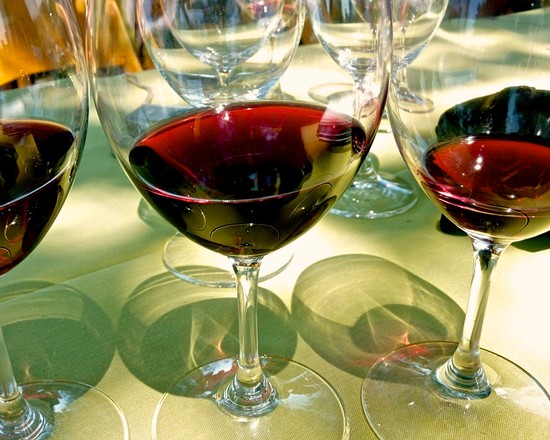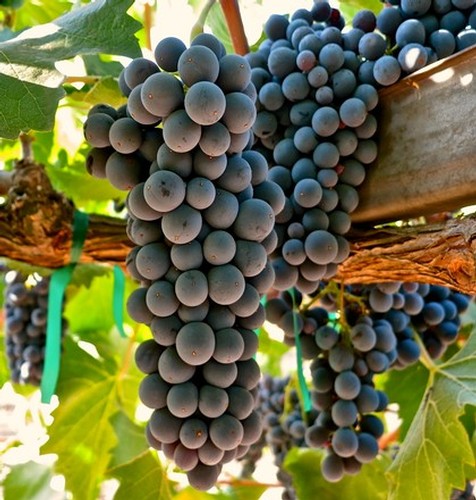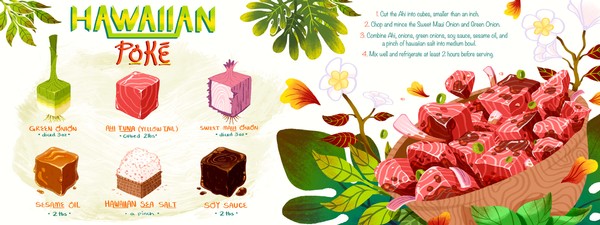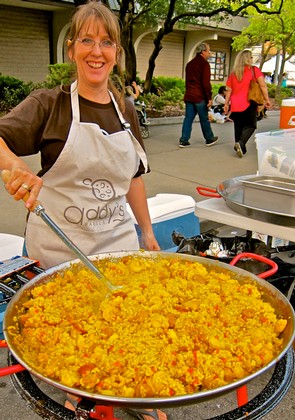Letters from Lodi
An insightful and objective look at viticulture and winemaking from the Lodi
Appellation and the growers and vintners behind these crafts. Told from the
perspective of multi-award winning wine journalist, Randy Caparoso.
The fine summer art of enjoying red wine with fish

It may be summer, but that doesn't mean every wine aficionado is reaching for white or pink wines. Red wine lovers are red wine lovers, and they're not going to let little things like 90-degree temperatures keep them from enjoying their preference.
Oh, they may make little adjustments, like going to slightly lighter reds; or easing up a little bit on red meat consumption (unless they're manning an outdoor grill). Be as it may, it is as good a time as any to revisit the notion of consuming red wine with fish. Not everyone, of course, has caught up with this.
But seriously, enjoying red wine with fish is not nearly as strange as it may seem. Fact of the matter is, there are many instances when a red wine tastes better with a seafood dish of some sort than any white wine or rosé. Why? Because as much as white wines with fish and red wines with red meat makes sense, not all seafood dishes are the same, and not all wines – reds, whites, pinks or sparklers – are either.
The idea of red wine with fish, in other words, is contextual – dependent upon the kind of seafood you’re eating, and the kind of wine at your disposal. But if you happen to prefer red wine over any other type of wine, it might be a good idea to think about how and when red wines do go great with seafoods.
Back in the 1989, in fact, two wine professionals by the name of David Rosengarten and Joshua Wesson actually published a book called Red Wine with Fish - The New Art of Matching Wine with Food (now sadly out of print), based on the premise that all wines and foods find ideal matches in two basic ways:
Similarities - When there are similar taste sensations in both a dish and a wine (examples: when the buttery sauce in a fish dish is enhanced by the a buttery texture of a barrel fermented white wine).
Contrasts - When sensations in a wine contrast with sensations in a dish to positive effect (example: when the sweetness in a white wine balances the saltiness of a dish like ham, cured sausage, or briny shellfish).

Wine and food matching, it is always good to remember, involves the same natural instinct you apply to all matters of aesthetics. You appreciate, for example, when violins in a musical score are played in harmony with similar instruments such as violas, cellos and double basses, while also played in contrast with woodwinds, drums and keyboards. Or when you dress in a morning: a black top, which can be worn with matching black heels along with a white skirt for contrast.
Our palates work in the same way as how we please our other senses: a scoop of vanilla ice cream is enjoyed with similar sweet sensations you get in bananas, chocolate syrup or a cherry, in contrast with sprinklings of slightly bitter nuts or the airy texture of whipped cream. Use of similar as well as contrasting food sensations that compliment each other is how we all put together our sandwiches for lunch or salads for dinner. It is what we teach, in more artful or original fashion, to young chefs in culinary schools to make our restaurant experiences more exciting.
So when thinking about how to enjoy red wines with seafood dishes, here are some basic concepts to mentally keep on file:
• Since more than anything, it is the bitter or hard tannin components common to red wine that are obstacles to matching fish or shellfish (a contrast that can be excessive contrast, like ketchup on ice cream), you turn to red wines that have very soft, rounded tannins, and leave the red wines with stronger, bitter tannins for fattier foods like red meat.
• Since almost all fish and shellfish are complimented by wines with some degree of contrasting acidity or tartness, it makes sense that red wines with a little more acid zestiness than other red wines will compliment a seafood dish; which means reds made from certain grapes that are naturally a little higher in acidity, or slightly lighter reds made from grapes picked a little earlier when sugars are lower and acids are higher.

The natural acidity in grapes like Sorelle Vineyards' Sangiovese play a key role in matching red with with fish
• Since red wines are indeed best with meatier dishes, it makes sense that meatier types of fish, with more fat and/or textural qualities, are easier to match with red wines.
• Since many of the dishes we put together are sums of their parts – seafoods combined with seasonings, spices, vegetables, stocks, sauces, etc. – it follows that we can increase the chances of successful red wine and fish matching by utilizing ingredients and techniques that are very conducive to the taste of red wine (like the taste of bacon, beef stock, onions, more pungent herbs or slightly bitter vegetables, etc.).
• Since red wines, by nature (i.e. fermented with skins, as opposed to whites which are not), are more complex than white wines, you can go one step further in your food preparation by consciously utilizing ingredients with some degree of umami; that is to say, “delicious,” high amino acid related components such as what you naturally find in mushrooms, soy sauce, sea vegetables, vine ripened tomatoes, stock reductions, aged cheeses like Parmigiano, etc.
That said, here are some specific red wine friendly foods we have known and enjoyed very well:
All tuna all the time
Seared rare or prepared raw (i.e. variations of sashimi, tartare or Hawaiian style poke), the higher grades of Pacific ‘ahi tuna are the seafood lovers’ “steak.” Because of its red fleshed, high fat meatiness, tuna is one of those fishes that 99% of the time are better matched with red wines than with whites, no matter how you eat it. The best matches? Red wines with soft tannin and expressive fruit qualities.

The meatiness of Pacific tuna and high umami sensations of soy sauce, onions and sesame oil all combine to produce a dish far better suited to soft yet zesty red wines than to any whites
Pinot Noir is an ideal match for tuna. While Lodi’s warm Mediterranean climate terroir is not usually associated with Pinot Noir, the fact of the matter is that there are over 2,000 acres of the grape grown in the region, primarily for big wineries, sparkling wine production, or to supplement specialty coastal producers. But when you find a Lodi appellation Pinot Noir, it is usually a very light, soft, fruit forward (lots of cherry-berry) and uncomplicated red – maybe not a Romanée-Conti or Williams Selyem, but still a delicious match for red fleshed tuna. Better Lodi grown examples include Ripken Vineyards, The Lucas Winery, Van Ruiten Family, and bottlings under Peltier Winery’s Hybrid or Oak Ridge Winery’s Old Soul labels.
Some Lodi producers, such as Mike McCay of McCay Cellars, are of the belief that “Lodi’s Pinot Noir” may very well be red wines made from the Grenache grape. McCay’s Lodi Grenache, in fact, is strikingly Pinot Noir-ish in its zesty edged exuberance of cherry-like perfume and earthy/dusty, dried herb spice, with an intrinsic peppery note that is more typically “Grenache” than Pinot-like. In a similar vein, the Oak Farm Grenache as well as Bokisch Vineyards’ Garnacha both come across as soft, zippy, and eminently red tuna-ready.
But wait, there’s more: Lodi grown reds crafted from Cinsaut – particularly those from Lodi’s oldest heritage planting, the acclaimed Bechthold Vineyard (planted in 1886) – are also very soft in tannin, with a zippy, magical red berry profile often compared to strawberry-rhubarb pie. Top producers include Fields Family, McCay Cellars, Estate Crush, Onesta Wines, Turley Wine Cellars, and Michael David Winery – we wouldn’t suggest any one of these Cinsauts over the other because, across the board, they are all round, fleshy, smooth and brilliantly perfumed red wines, all capable of making red tuna dishes seem like the most natural red wine with fish match in the world.
Charred or smoky salmon
Cooked salmon might retain its pink color, and tends to be a little less meaty and slightly stronger in the taste of fish oils than tuna, but it still falls within the category of fish dishes that are usually better matched with red wines than whites. Especially when you apply preparations resulting in more aggressive sensations – like smoking, wood roasting or grilling, as well as crusting with pungent herbs and/or peppercorns – which can give you striking notes of similarity to the taste of red wines that are finished with perceptible degrees of slightly smoky oak qualities from barrel aging.

Is varietal red Grenache the "Pinot Noir" of Lodi?
The Native American style of open-fire cedar plank roasted salmon, for instance, practically screams for a slightly smoky, handsomely oak-aged red wine (re a cedar plank salmon recipe for home). Pinot Noir, which is commonly aged in well toasted French oak barrels, is the obvious choice, but in our experience, wood smoked salmon has proven surprisingly amenable to even red wines of sturdier tannin substance. In Napa Valley, for instance, it’s not unusual to see some of the more finesse style Cabernet Sauvignons served with smoky wood roasted salmon.
But if Cabernet Sauvignon and salmon is going a little too far for you (Napa folks have been known to serve Cabernet Sauvignon with peppercorn or chile pepper spiced fresh fruit soups, for Pete’s sake), we have our own natural red wine match in plentitude: Lodi’s zesty yet soft, fruit forward, mildly peppery spiced and often earthy/loam nuanced styles of Zinfandel. You don’t have to go far to find examples that have the ease of tannin and nuanced smokiness that fit with a smoky, grill charred or herb/peppercorn crusted salmon dish like a hand in glove: Michael David’s ubiquitous, smoke and autumn spiced 7 Deadly Zins, for one; and many of the smoothly oaked, value priced ($10-$20) offerings of Lodi based wineries such as LangeTwins Family, Jessie’s Grove’s Earth, Zin & Fire, Peirano Estate, Klinker Brick, Van Ruiten Family, or Oak Ridge. You may find an even finer salmon match in more smoothly styled premium priced Lodi Zinfandels ($20-$40) by producers like Estate Crush’s Stellina, Mettler Family, Harney Lane, Heritage Oak, St. Amant, Fields Family, McCay, Oak Farm, or Bokisch’s Tizona – really, more than we can shake a stick at!
But there is still another ideal choice for smoky, herby or peppery salmon: Sangiovese – a red wine varietal native to Italy that is usually sleek in tannin, with a slightly zestier natural acidity than most Zinfandels. Sorelle, Jeremy Wine Co., and Macchia are all producers of first class, subtlely oak influenced Lodi grown Sangiovese making an easy match for salmon, whether off the grill, out of a smoker, oven roasted or pan fried.
Oysters any way
At the Grand Central Oyster Bar in New York’s Grand Central Station, they’ll tell you that a soft, zippy Pinot Noir or French Beaujolais is just as good a match for raw oysters as a sharply dry Sauvignon Blanc. This might not work for you, but if it does it’s because of umami factors: the way that savory, high amino acid components in oysters mingle with the taste of softer tannin, spice, smoke, mineral and earth nuanced red wines such as Pinot Noir, as well as Grenache, Cinsaut, Carignan, Sangiovese, or easier drinking styles of Zinfandel.

Oysters on the grill at Borra Vineyards
But if you’re skeptical, try this at home: simply grill them in the shell, cup-side down and covered (doesn’t take more than 2, 3 minutes before they start to open up, and ready to be pried and consumed), and you will find that smoky sensations in both oak-influenced red wines and bivalves working in delicious synchronicity, with umami sensations working overtime. But whether you’re consuming oysters by themselves, baked in any number of ways (with anything from chopped smoky bacon to sweet-spicy salsas), or added to stews, rice or pasta dishes, the point is that umami-rich oysters are strong enough to be perfectly natural, maybe even preferable, with smooth styles of barrel-aged reds.
Mussels
Like oysters, strongly earthy mussels – even when stewed as it usually is in seafood stock and white wine – are one of those seafoods that open up to either crisp dry whites (offering contrasting notes of acidity) or softly textured reds (offering similarities of earth tones). An interesting thing to try is juxtaposing the two wine types, the white served chilled and the red served slightly chilled (60 minutes in the fridge), and you’ll see how Wesson and Rosengarten’s principles of similarity and contrast work in two different ways.
One particularly surprising match: suave, rounded red wines made from the Tempranillo grape, which tend to have more of a dusty suede-like texture when grown in Lodi's sandy Mediterranean terroir (in other parts of the West Coast, Tempranillo can be quite big with tannin). Lodi's lanky, loose limbed style of Tempranillo (better ones produced by Bokisch Vineyards, Harney Lane, Fields Family,McCay, m2, Peirano, and Riaza) has a way of expressing earth toned complexities in the context of dishes utilizing mussels; not too much different than what happens when Tempranillo is tasted with gamey lamb.

Lodi's multi-award winning Addy Grant (Addy's Paella) cooking up an aromatic storm
Charred scallops
One of the signature dishes of San Francisco chef Traci Des Jardins is scallops pieced together with aromatic truffled mash potatoes. She’s also not opposed to browning in butter with smoked bacon and Brussel sprouts, or any which way that arouses the senses through the nose. In fact, whenever scallops are flash charred and scented with earth tones and umami driven sensations they become dishes best suited to smooth styles of red wine rather than whites. And when scallops are combined with winey balsamic syrups, cured meats like prosciutto or earthy vegetables like spinach or mushrooms, they are all the more likely to taste better with a scented Pinot Noir, a soft and fleshy Grenache, a fragrant Cinsaut, or an easy drinking Zinfandel.
Mixed seafood dishes
Two of the most famous ways of mixing fish and shellfish together in one skillet are in dishes like bouillabaisse (originating in Southern France) or cioppino (the San Francisco favorite originating from emigrants of Genovese-Italian descent) – the former fused together by saffron, one of the earthiest and most elemental of spices, and the latter laced with sweet/sharp tomatoes and winey broths that effortlessly fuse with the natural fruit sensations of red wines.

Pungent threads of saffron knit seafood dishes to red wines
Then there are the endless variations of paella – rice dishes also based on saffron and cooking in earthy seafood stocks. Whenever you combine seafoods in these classic ways you are essentially piling on a plethora of high umami components – the one taste sensation that sings most sweetly with soft, multifaceted forms of red wine. Both saffron and tomatoes only intensify the need.
Finally, there is crawfish, that universally beloved freshwater crustacean: in the recipes that evolved in Louisiana – particularly étoufée and jambalaya – strongly skewed towards red wine friendly ingredients like chopped onions, bell peppers and celery (the Cajun-Creole “holy trinity”), along with umami-rich tomatoes, earthy okra, pungent scallions, and layers upon layers of spices and seasonings that demand the complexity of red, rather than white, wines. The most reliable match? Probably an all-American red wine like Lodi grown Zinfandel, with its typically jammy fruitiness that smooths over strong seasonings, while the wine’s natural cracked peppercorn spiciness strikes surprisingly (always!) delectable notes of similarity with peppery Cajun-Creole spices.
So if you love red wine but don’t want to serve yourself slabs of red meat every night of the summer, stick to the modern day tried-and-true: red wine with fish.

Source of amazing red wine for fish: Lodi's Bechthold Vineyard Cinsaut